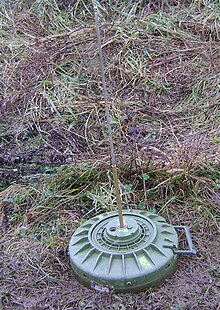TMRP-6
| TMRP-6 | |
|---|---|
| General Information | |
| Designation: | TMRP-6 |
| Type: | Anti-tank mine |
| Country of origin: | Yugoslavia |
| Technical specifications | |
| Combat weight: | 7.2 kg |
| Charge: | 5.1 kg of TNT |
| Diameter: | 290 millimeters |
| Height: | 132 millimeters |
| Detonator: | Pressure igniter / knee igniter / remote igniter |
| Lists on the subject | |
The TMRP-6 ( T enkovska M ina R azorno P robojna-6) is an in the former Yugoslavia produced anti-tank mine with a mechanical fuze and projectile-forming hollow charge .
description
The mine body and the pressure cover of the TMRP-6 are made of plastic, the top of the mine is ribbed (reinforced housing ). The mine detonator is inserted into the pressure cover, a kink rod made of metal is always attached to the pressure cover. The mine has a secondary ignition channel in the middle on the underside to accommodate a recovery fuse, and on the side there is a plastic handle. It is always colored green and delivered in wooden boxes of four. It was considered one of the most modern of the anti-tank mines used during the Yugoslav wars.
Use and function with buckling rod
When laying the mine, the folding rod is put on and the desired release time is selected. After pressing the unlocking bolt, the mechanical clockwork starts audibly and the unlocking time runs out. This unlocks the spring sleeve and the lower part of the igniter. If the buckling bar is now loaded with 1.3 to 1.7 kilograms from the side, its receptacle moves the spring sleeve downwards against the force of its spring. The locking ball is pressed outwards and releases the preloaded firing pin. This hits a primer, the flame of which ignites the evacuation charge and the delay set. The clearing charge separates the pressure cover with the upper fuse part from the lower fuse part of the mine body. After a delay of one to four seconds, the detonator and the active charge of the mine are ignited via the booster charge.
The mine is generally laid on the ground with a folding rod. If the vehicle hull of a vehicle driving above it catches the articulated rod, the projectile-forming shaped charge is triggered by the time delay of one to four seconds directly under the hull and can thus achieve its full effect. The mine was also attached to trees, walls or tunnel ceilings with a folding rod in order to fight passing objects from the side or from above. Your energy is sufficient to destroy a main battle tank . Since the stick reacts to a low pressure of just three kilograms (or movements of over three millimeters), the mine can also be triggered by a person without any problems.
Use and function with pressure release
If the mine lid is loaded with 150 to 300 kilograms, it is pushed into the mine. This moves the firing pin guide with the firing pin and locking ball upwards until it can enter the recess in the spring sleeve. The firing pin is released and strikes the primer. The resulting flame initiates the clearing charge and the delay set, which in turn initiates the active charge with hollow charge.
The pressure release without a folding rod is the less common variant, as this requires a direct approach to the mine. As a result, the shaped charge only acts on the chains or wheels of a vehicle and can therefore not develop its destructive effect optimally.
Detonators and space fuses
The mine has the built-in standard detonator UTMRP-6 (push / kink), but can also be triggered remotely by an electric detonator.
To prevent the mine from being simply picked up and cleared aside, it can also be secured with the pressure relief fuse UMOP-1 or the draft fuse UMP-1 ( recovery protection ). In addition, these mines were often surrounded by anti-personnel mines .
Areas of application
The mine was introduced and used by the states of Slovenia , Croatia , Bosnia and Herzegovina , Serbia , Kosovo and Macedonia .
See also
Web links
Individual evidence
- ↑ a b c TMRP-6 Antitank Mine ( Memento from January 13, 2011 in the Internet Archive )

